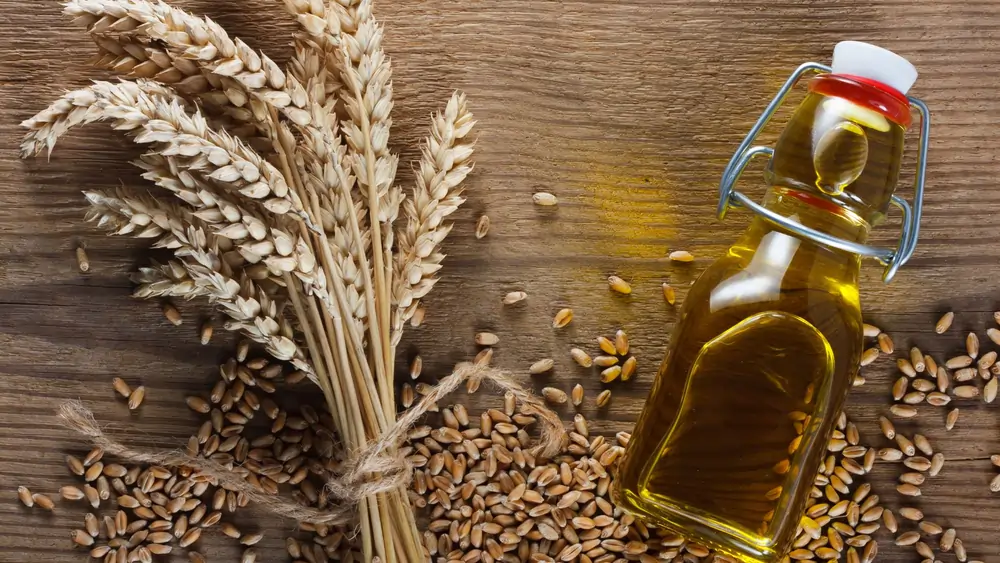In recent years, the attention surrounding the benefits of wheat germ for hair and health has surged. Combine all the nourishing vitamins, minerals, and nutrients present in the wheat kernel, and you get the concentrated powerhouse known as wheat germ.
In this article, I’ll guide you into the nutritional composition of wheat germ and explore its various applications in promoting healthier, more vibrant hair. Whether you’re dealing with dryness, damage, hair loss or seeking to enhance the natural beauty of your hair, understanding the benefits of wheat germ can be the key to unlocking a luscious mane.
What is Wheat Germ?
Wheat germ (Triticum vulgare), the embryonic center of the wheat kernel, is a powerhouse of nutrients that play a crucial role in supporting overall health. Often discarded during the milling process to produce refined wheat flour, wheat germ is a rich reservoir of vitamins, minerals, and essential fatty acids.
Remarkably, a mere ounce of wheat germ can provide a significant portion of the daily requirements for thiamine, folate, phosphorus, manganese, and selenium. Unfortunately, during the refining process that transforms whole wheat grains into white flour, the wheat kernel containing the wheat germ is removed.
Regrettably, this means that unless specifically labeled as 100 percent whole wheat, most wheat products such as bread, baked goods, cereals, and pasta lack the nutrient-rich goodness inherent in wheat germ.
Wheat Germ Benefits
Throughout history, various cultures have recognized the value of wheat germ for its nutritional benefits. Ancient civilizations, such as the Egyptians, revered wheat for its life-sustaining properties. Wheat germ, with its life-giving potential, has found its way into traditional remedies and culinary practices across different societies.
Research suggests wheat germ contributes to overall health by providing essential nutrients, antioxidants, and dietary fiber, supporting cardiovascular health, digestive well-being, and immune system function.
In recent times, the spotlight has also turned to wheat germ for its potential contributions to hair health. Packed with nutrients like Vitamin E, omega‑3 fatty acids, and proteins, wheat germ offers a natural and holistic approach to nourishing the hair from the roots to the tips.
Nutritional Composition of Wheat Germ
Wheat germ stands out as a nutritional powerhouse, boasting a diverse array of essential nutrients vital for overall well-being. Understanding the key components provides insights into how wheat germ can positively impact hair health.
- Vitamin E: Wheat germ is renowned for its exceptionally high content of vitamin E, a potent antioxidant known for its ability to neutralize free radicals. In the context of hair health, vitamin E contributes to improved blood circulation in the scalp, fostering an environment conducive to hair growth.
- Omega‑3 Fatty Acids: Essential fatty acids, including omega‑3s, play a crucial role in maintaining the integrity of cell membranes. Incorporating wheat germ into your diet or hair care routine can contribute to a healthier scalp and hair follicles, potentially reducing issues like dryness and brittleness.
- Protein Content: Proteins are the building blocks of hair, and wheat germ is a notable source of plant-based proteins. These proteins can help strengthen hair strands, preventing breakage and promoting overall hair resilience.
- B‑Vitamins (Biotin, Niacin): Biotin, a B‑vitamin found in wheat germ, is often associated with promoting hair growth and overall hair health. Niacin, another B‑vitamin, is crucial for maintaining a healthy scalp and supporting the structure of hair follicles.
The amalgamation of these nutrients makes wheat germ a potent ally in the pursuit of healthier and more vibrant hair. Vitamin E’s antioxidant properties, omega‑3 fatty acids’ moisturizing effects, the strengthening power of proteins, and the hair-loving benefits of B‑vitamins collectively contribute to a comprehensive approach to addressing various hair concerns.
Wheat Germ Benefits for Different Hair Types
Understanding how wheat germ caters to specific hair needs allows individuals to tailor their hair care routine to address unique concerns. Whether aiming to combat dryness, enhance shine, or promote hair growth, wheat germ emerges as a natural and versatile solution for a wide range of hair types and conditions.
Wheat germ for dry and damaged hair
Wheat germ’s omega‑3 fatty acids penetrate the hair shaft, providing deep hydration. This makes it particularly beneficial for individuals with dry, brittle, or damaged hair, helping to restore moisture balance and improve overall hair texture.
The protein content in wheat germ contributes to repairing and strengthening the hair’s structure, minimizing split ends. Regular use of wheat germ-based products or treatments can be a natural way to address and prevent further damage.
Wheat germ for promoting shine and smoothness
Vitamin E in wheat germ contributes to a natural shine by promoting scalp health and nourishing hair follicles. This imparts a healthy luster to the hair, enhancing its overall appearance.
Wheat germ oil’s conditioning properties help in detangling hair and reducing frizz. This makes it an excellent choice for those looking to achieve smoother, more manageable hair without the use of synthetic ingredients.
Wheat germ for addressing hair loss and thinning
Wheat germ’s vitamin E content supports a healthy scalp environment, which is crucial for minimizing hair loss. Nourishing the scalp can contribute to stronger hair follicles and potentially reduce excessive shedding.
Just like the best peptide for hair growth, the proteins in wheat germ play a vital role in strengthening hair strands, addressing issues of thinning by improving the overall resilience of the hair. Regular use may contribute to thicker and fuller-looking hair.
Wheat germ for maintaining overall hair health
The diverse array of nutrients in wheat germ, including B‑vitamins and omega‑3 fatty acids, ensures comprehensive nourishment for the hair. This promotes overall hair health, from root to tip.
Wheat germ’s antioxidant properties help protect hair from environmental damage, such as exposure to UV rays and pollution. This can be especially beneficial for individuals living in urban areas or those with an active outdoor lifestyle.
Scientific Evidence Of Wheat Germ Benefits For Hair Health
Wheat germ’s potential benefits for hair health are supported by a growing body of scientific research. Numerous studies have explored the nutritional composition of wheat germ and its application in promoting hair growth and overall hair well-being.
Research has demonstrated the positive effects of vitamin E on hair health. A study published in the Journal of Cosmetic Dermatology found that vitamin E supplementation improved hair growth and increased the number of hairs in the anagen (growth) phase.
The Journal of Nutrition and Health Sciences published a study highlighting the role of omega‑3 fatty acids in improving hair quality. Wheat germ, being a rich source of these fatty acids, is implicated in contributing to enhanced hair texture and shine.
The International Journal of Trichology featured a study emphasizing the importance of dietary protein in preventing hair damage and promoting hair strength. Wheat germ’s protein content can contribute to these protective effects.
Wheat Germ in Hair Products
As consumer demand for natural and holistic hair care solutions grows, the inclusion of wheat germ in commercial products has expanded. The versatility of wheat germ, addressing diverse hair concerns, positions it as a promising ingredient in the ever-evolving landscape of hair care.
Wheat Germ Supplements
Wheat germ supplements are capsules or tablets that concentrate the nutritional components of wheat germ into an easily consumable form. This includes essential nutrients like vitamin E, omega‑3 fatty acids, and proteins.
The Ideal of MeD hair vitamins offer a convenient way to ensure a consistent intake of wheat germ’s beneficial nutrients. This can be particularly advantageous for individuals with busy lifestyles who may find it challenging to incorporate wheat germ into their diet or hair care routine daily.
Supplements allow for a more precise and controlled intake of wheat germ’s key nutrients, potentially enhancing their targeted benefits for hair health. This controlled dosage can be appealing for those seeking specific outcomes, such as hair growth or improved hair texture.
Hair Care Products Containing Wheat Germ
At Ideal of MeD, we have embraced the benefits of wheat germ, incorporating it into our shampoo and conditioner. These products aim to provide a daily dose of wheat germ’s nourishing properties to promote overall hair health.
Wheat Germ Oil
Wheat Germ oil is a potent elixir for hair health. Apply a few drops directly to the scalp, massaging gently, or mix with your favorite carrier oil for a nourishing hair mask. Its proteins and antioxidants strengthen strands, reduce breakage, and promote a glossy, revitalized mane.
Wheat Germ Dosage
While there isn’t an official recommended daily allowance for wheat germ, the Ideal of MeD Hair Vitamins, which contain wheat germ, recommend a daily intake of 2 tablets.
Alona’s Expert View
I often recommend our products with wheat germ to those dealing with hair issues. The nutrients and antioxidants present can contribute to a healthier scalp environment and support hair growth.
While wheat germ can offer numerous benefits, it’s essential to complement its use with a well‑rounded approach to hair care. This includes a balanced diet, proper hydration, and a suitable hair care regimen tailored to individual needs.
Wheat Germ Benefits for Overall Health
Beyond its remarkable impact on hair health, wheat germ offers a myriad of benefits for overall well‑being. Let’s explore the holistic advantages that this nutritional powerhouse brings to the table.
- Rich in Antioxidants: Wheat germ is a treasure trove of antioxidants, with vitamin E leading the charge. These antioxidants play a crucial role in neutralizing harmful free radicals in the body, helping reduce oxidative stress, inflammation, and chronic disease risk.
- Cardiovascular Health: The presence of omega‑3 fatty acids in wheat germ can support heart health by promoting healthy cholesterol levels, reducing inflammation, and enhancing overall cardiovascular well‑being.
- Enhanced Digestive Health: Wheat germ is a rich source of dietary fiber, which promotes digestive health by regulating bowel movements, preventing constipation, and supporting a healthy gut microbiome.
- Boosts Immune System: The combination of vitamins, minerals, and antioxidants in wheat germ works synergistically to strengthen the immune system. Nutrients such as zinc, selenium, and B‑vitamins contribute to the body’s defense mechanisms.
- Supports Energy Metabolism: B‑vitamins like thiamine, riboflavin, and niacin in wheat germ play pivotal roles in converting food into energy, supporting vitality and preventing fatigue.
- Skin Health: The same antioxidants and essential fatty acids that benefit hair health also help maintain healthy skin. Wheat germ’s nutrients support elasticity, hydration, and may help reduce signs of aging.
- Nutrient‑Dense Superfood: Wheat germ stands out as a concentrated source of essential nutrients. Incorporating it into your diet can provide a simple yet effective way to ensure diverse vitamin and mineral intake.
Wheat Germ Potential Risks and Precautions
Individuals with known wheat allergies should exercise caution when using wheat germ-based products. Allergic reactions may manifest as redness, itching, or swelling. A patch test is advisable before widespread application.
While wheat germ oil is generally considered gluten-free, individuals with gluten sensitivity should be mindful of potential cross-contamination during processing. Opt for certified gluten-free products when necessary.
Individuals with existing skin conditions such as eczema or psoriasis should seek guidance from dermatologists before introducing new products, as wheat germ’s nutrient richness may interact with certain conditions.
Wheat Germ Benefits For Hair: Conclusion
In the quest for healthier, more vibrant hair, the inclusion of wheat germ emerges as a natural and multifaceted solution. From its historical significance to its contemporary application in both DIY treatments and commercial products, wheat germ stands out for its rich nutritional composition and versatile benefits.
As we explore the nutritional components of wheat germ, its role in promoting hair growth, and its varied applications for different hair types, it becomes evident that this unassuming grain harbors a treasure trove of potential for hair care enthusiasts. Scientific studies have underscored the positive impact of wheat germ, providing a foundation for its traditional uses.




